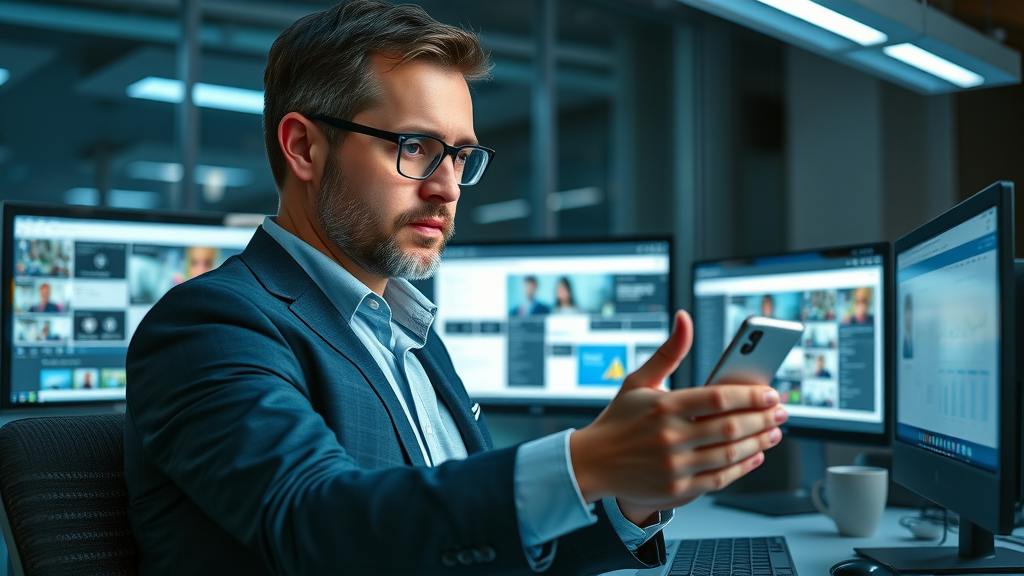Did you know that companies with a documented content marketing strategy see up to 6x higher conversion rates than their competitors? Content marketing isn’t just a digital buzzword—it's reshaping how modern brands grow, connect, and thrive. In this ultimate guide, you’ll uncover the essential frameworks, tactics, and mindset shifts to master content marketing, elevate your business goals, and carve out your niche—no matter your industry. Whether you’re a marketer, solopreneur, or brand strategist, you're about to discover why mastering content marketing is your next must-have advantage.
Harnessing the Power of Content Marketing Strategy: An Eye-Opening Shift in Modern Marketing
The digital marketplace has evolved, and an effective content marketing strategy is the new engine that drives business growth. Today’s consumers crave valuable, relevant, and engaging content that speaks to their pain points and guides their decision-making. Whether it’s a detailed blog post , captivating social media content, or an insightful video, what sets a brand apart is its ability to deliver the right message at the right time.
Businesses implementing a solid content marketing strategy don’t just generate more leads; they build brand awareness , nurture trust, and convert potential customers into loyal advocates. For instance, consider a SaaS company with a robust content plan that covers tutorials, case studies, and insightful guides. Such a strategy not only answers audience questions but also positions the brand as an industry thought leader—leading to higher conversion rates and market share.

- Recent research shows that companies deploying an effective content marketing strategy experience 6x higher conversion rates than their competitors. Discover how a content marketing strategy can transform your brand’s impact.
Unlock the Foundations: Understanding Content Marketing Strategy and Its Role in Business Growth
At its core, a content marketing strategy is a blueprint for how your business will create, distribute, and manage content to achieve specific objectives. Unlike sporadic marketing efforts, this comprehensive approach is closely aligned with your business goals—be it lead generation, brand awareness, or customer retention. As digital landscapes become more competitive, a robust content strategy ensures your messaging cuts through the noise and resonates with your target audience .
The importance of a content marketing strategy is undeniable for modern businesses looking to build trust and engage potential customers throughout their journey. Integrating content strategy with your overarching marketing strategy amplifies your reach, delivers consistent value, and positions your company for sustained growth. Businesses lacking a strategic content plan often miss the mark, resulting in wasted resources and underwhelming marketing ROI.
- Definition of content marketing strategy, its importance for modern businesses, and how it connects to overarching marketing strategy.
Key Elements of a Successful Content Marketing Strategy
- Aligning your content strategy with business goals and objectives
- Identifying and understanding your target audience
- Developing a clear and actionable content plan
What You'll Gain from Mastering Content Marketing Strategy
Delving into this guide, you’ll uncover the keys to identifying profitable content types and selecting formats that directly support your strategic objectives. You'll learn not only how to structure a results-driven content plan but also how to measure its impact and optimize for ongoing success. Best practices sourced from top-performing brands will help you craft effective content that elevates your brand awareness and drives customer loyalty.
Mastering a successful content marketing strategy positions you to make smarter data-driven decisions, continually optimize your campaigns, and double down on what works. Armed with these actionable insights, you’ll be able to adapt your methods for consistently improved marketing efforts, ultimately propelling your business ahead of the competition.

- Insights into profitable content types and formats
- How to structure a results-driven content plan
- Best practices for creating effective content and boosting brand awareness
- Measuring and optimizing your marketing strategy for continuous growth
Examining the Pillars of Content Marketing and Content Strategy
A high-impact content marketing strategy stands on several essential pillars. These include aligning content with business goals , understanding your audience, choosing the right types of content , and ensuring seamless distribution across digital channels. Recognizing the difference between content marketing , content strategy , and a content plan empowers you to create content that supports both short-term campaigns and long-term brand authority.
Think of these pillars as interconnected blocks—each dependent on the other to drive effective results. Content marketers who excel at strategy know how to harmonize these elements so that every piece of content, from blog posts to videos, is purposeful, targeted, and measurable. This cohesive approach leads to successful content marketing campaigns that not only attract attention but also inspire engagement and conversions.

Differentiating Content Marketing, Content Strategy, and Content Plan
While often used interchangeably, content marketing , content strategy , and content plan serve unique yet complementary functions. The content strategy is your overarching vision—it defines your why, who, and what in terms of media content direction. Content marketing refers to the execution: harnessing blogs, videos, infographics, or podcasts to meet your business objectives. Meanwhile, the content plan outlines the what, when, and where—organizing publishing schedules and ensuring accountability.
Understanding these distinctions removes confusion, prevents overlap, and boosts team collaboration—resulting in seamless content creation and delivery. This clarity also allows you to adapt quickly to changing trends or audience needs, a necessity in modern digital marketing.
- Understanding the unique roles each plays in your broader marketing strategy.
Integrating Content Marketing with Social Media and Digital Channels
Integration is non-negotiable: your content marketing strategy reaches its full power when seamlessly woven into your digital channels. Platforms like social media , email marketing, and web publications offer dynamic spaces to engage with your target audience in real time. Each channel demands slight adaptation—blog posts, for example, may be repurposed into visually engaging infographics for Instagram or insightful threads on LinkedIn.
Synchronizing your messaging across these platforms ensures consistency, amplifies your brand’s voice, and maximizes the reach of every content type. A holistic strategy leverages trends in social media content and emerging technologies, helping your marketing efforts capture attention and foster meaningful conversations.
- Adapting your content marketing strategy for social media and various digital platforms.
“Content marketing is more than writing blog posts—it’s about delivering value that builds trust with your audience.”
Setting Business Goals: Aligning Your Content Marketing Strategy with Long-Term Success
Everything starts with clear, measurable business goals . Aligning your content marketing strategy to these objectives ensures your marketing efforts aren’t wasted on vanity metrics but instead focus on KPIs that matter—like lead generation, organic traffic, and conversion rates. Setting milestones for your strategy, whether quarterly targets or campaign-specific outcomes, paves the way for transparency and accountability for your marketing team.
For instance, if your business seeks to double its subscriber base in a year, your strategy might prioritize educational blog posts and lead magnets. Setting these goals enables you to create content with a concrete outcome in mind, ensuring every piece works toward your overall mission.
Defining Clear, Actionable Business Goals
Effective content marketers define what success looks like from the start and establish systems to track performance along the way. Your KPIs may include web traffic, engagement metrics (likes, shares, comments), email subscribers, or even direct sales. Tracking the ROI of your content marketing strategy highlights which content types resonate, identifying optimization opportunities for continuous growth.
Having clear, actionable goals means you can adjust your strategy on the fly, double down on winner campaigns, and sunset approaches that fall short. Top-performing brands revisit their business objectives regularly, ensuring ongoing alignment with their evolving content plan.
- Establishing KPIs and tracking content marketing ROI.
| Business Goal | Content Strategy Metric |
|---|---|
| Increase Website Traffic | Organic Sessions, Blog Post Views |
| Build Brand Awareness | Social Shares, Impressions, Mentions |
| Generate Leads | Lead Magnet Downloads, Newsletter Signups |
| Improve Conversion Rates | Landing Page Conversions, CTA Clicks |
Driving Brand Awareness and Lead Generation Through Effective Content
Compelling content, aligned to precise business goals, can supercharge both brand awareness and lead generation. By developing content tailored to various stages of the buyer journey, you provide value and insight that builds credibility and trust. Educational resources, in-depth case studies, and engaging social content all play distinct roles in moving potential customer toward a conversion.
When each campaign and blog post is linked to a clear goal—whether it's more followers on social media or higher webinar registrations—tracking and optimization become natural parts of the workflow. This targeted approach transforms strangers into leads, leads into customers, and, ultimately, customers into advocates for your business.
Audience-First Approach: Identifying and Understanding Your Target Audience
At the heart of every successful content marketing strategy is a deep understanding of your target audience . Start by analyzing demographic data, pain points, and preferences to ensure your content creation efforts resonate. Harness analytics, social media listening, and customer feedback to unearth the real motivations and challenges of your market, allowing for hyper-personalized messaging that breaks through.
With a well-defined sense of your audience, your marketing efforts become focused and effective. You’ll create content that addresses genuine needs while fostering a sense of community and loyalty—a must for driving engagement and boosting marketing ROI.
Creating Detailed Audience Personas for Targeted Content Marketing
Developing detailed audience personas brings laser-focus to your content plan . By mapping out buyer journeys, pain points, and preferred content types, you can tailor everything from blog posts to videos for maximum relevance. Tools like Google Analytics, Facebook Insights, or LinkedIn Analytics can provide invaluable data for this segmentation, helping you discover what your audience consumes—and shares—the most.
High-performing content marketers regularly update personas, ensuring their strategies evolve alongside shifting audience expectations and market trends. This habit ensures the ongoing effectiveness of your marketing strategy and keeps your messaging one step ahead of competitors.
- Utilizing analytics and social media insights for effective targeting.

Adapting the Content Strategy for a Changing Demographic
Demographic shifts are inevitable—your content marketing strategy must be as agile as your audience is dynamic. By segmenting your audience based on behavior, life stage, or emerging trends, you ensure your content creation stays ahead of the curve.
Personalization at scale means using data to deliver the right message, in the right format, via the right channel. Segmentation tools within social media and CRM platforms make it possible to tweak your approach in real time, creating a positive feedback loop for marketing optimization.
- Segmentation strategies for personalized content delivery.
Mastering Content Creation: Building a Library of Valuable Media Content
A robust content marketing strategy thrives on a diverse library of valuable media content . Variety not only keeps your brand fresh but also caters to the unique consumption habits of your target audience. Bloggers, video producers, and infographics designers all shape your brand’s authority, reach, and trustworthiness online.
The challenge for content marketers lies in prioritizing the right content types and formats that support your business goals. Successful brands experiment boldly—mixing evergreen blog posts, time-sensitive news pieces, engaging videos, and interactive webinars—to drive sustained engagement and ROI.
Exploring Content Types and Formats: From Blog Posts to Video and Social Media Content
From in-depth blog posts to high-impact videos and engaging social media content , your content strategy’s success depends on tailoring formats to both audience preferences and campaign objectives. Assess what works best for your niche—from written guides to podcasts, webinars, or downloadable resources.
Review analytics to determine which content types yield the most engagement, then double down on those. Diversifying content keeps your audience invested and positions your brand as a go-to resource in your industry.
- Selecting content types aligned with business goals and your content marketing strategy.

Developing an Effective Content Calendar and Publishing Schedule
A well-maintained content calendar is the backbone of consistent, effective content marketing. It ensures deadlines are met, themes remain timely, and teams stay synchronized. Tools like Trello, Asana, or Google Calendar streamline the content planning workflow, helping you map out weeks—or even months—of blog posts, email campaigns, and social shares in advance.
Your calendar should accommodate editorial flexibility: keep space for real-time opportunities, trending topics, or last-minute ideas. Brands that succeed with content marketing often treat their calendar as a living document, adapting schedules as data and priorities shift.
- Tools for streamlined content planning and production.
Crafting Effective Content: Writing for Engagement and SEO
Effective content creation is a balancing act—combining compelling storytelling, value-driven messaging, and technical SEO. Each piece, from the smallest blog post to comprehensive guides, should engage readers and solve their pain points, while also serving the goals of your content marketing strategy.
Search engines reward content that is original, relevant, and structured for readability. Employ best practices like keyword research, engaging headlines, and multimedia elements to unlock organic growth and ensure your brand stands out in crowded SERPs.
Techniques for Creating Compelling, Effective Content
Great content marketing hinges on resonance—using storytelling to draw connections between brand values and audience aspirations. Start each blog post with a hook that addresses a timely pain point or shares a bold fact. Layer in value-driven insights, actionable tips, and real-world examples to keep readers engaged.
Finish with clear calls to action. Whether it’s encouraging a share or prompting a download, every piece of content should move the reader further down the funnel, supporting both engagement and your core business goals.
- Storytelling, value-driven messaging, and actionable blog posts.

Optimizing Your Content for Search Engines and Social Media
Optimizing for both search engines and social media is essential for effective content marketing. Use keyword research to guide topic selection, internal linking to boost SEO health, and mobile-friendly formatting to enhance accessibility. Incorporate relevant hashtags, meta descriptions, and shareable visuals in your social posts to boost discoverability.
Analyze performance data regularly, adjust your strategy for high-performing formats, and stay ahead of algorithm updates to maintain an edge in search and social. This holistic approach maximizes organic reach and multiplies the return on your content marketing investment.
- Integrating SEO best practices into your content marketing strategy.
Distribution and Amplification: Getting Your Content Seen
Even the most brilliant content is wasted if your target audience never sees it. The distribution phase of your content marketing strategy is where you select, test, and optimize the digital channels that fit your goals and resources. Whether it’s owned (email, website), earned (PR, guest posts), or paid (social ads, sponsored posts), each channel offers unique opportunities to amplify your reach.
Top brands maximize their distribution with a multi-channel approach: leveraging influencer partnerships, syndicating content, and using paid promotion to scale their messaging. The result is a content lifecycle with extended visibility and impact.
Choosing the Right Channels for Content Distribution
Your choice of distribution channels should align with your target audience’s online behavior and preferences. Email marketing remains a powerful tool for nurturing leads and driving direct traffic. Social media platforms let you engage in real time, while influencer partnerships can introduce your brand to entirely new audiences.
Test and refine your distribution mix regularly, tracking which channels yield the best reach and conversions. Consistent monitoring ensures your content finds its way to the people most likely to engage and share.
- Email marketing, social media, influencer partnerships, and beyond.
Maximizing Reach with Repurposing and Content Lifecycles
Efficiency is crucial: repurposing high-performing content into new formats—blogs into videos, webinars into guides—multiplies your efforts and scales your content marketing strategy without huge resource demands. This maximizes ROI and gives your content longer, more impactful lifecycles.
A best practice is to develop pillar content—comprehensive assets that can be broken down or refreshed regularly. Share excerpts on social media, expand on related topics in spin-off blog posts, and keep your top-performing pieces in digital rotation.

- Scaling your content marketing strategy with minimal resources.
“The right content, delivered at the right time, to the right audience, can change everything.”
Measuring Success: Analyzing, Optimizing, and Sharpening Your Content Marketing Strategy
Great content marketers treat measurement as an ongoing discipline. Analyzing key performance indicators (KPIs)—like engagement rates, SEO gains, and conversion improvements—provides critical feedback loops for continuous strategy refinement. Successful content marketing relies on tracking not only output, but also impact, ensuring every marketing effort is purposeful and scalable.
Develop a culture of experimentation: try new topics, formats, and channels, track results, and pivot quickly when data suggests new opportunities or pain points. This iterative approach keeps your content plan future-proof and focused on growth.
Key Performance Indicators (KPIs) for Effective Content Marketing
Determine which KPIs best reflect your business goals. Common content marketing KPIs include page views, time on site, bounce rates, social shares, backlinks, email open and click-through rates, and sales attributed to content campaigns. Use an analytics dashboard to visualize trends and identify outliers, enabling fast, data-driven decision-making.
Continually reporting and benchmarking these metrics allows for realignment of the strategy, directing investments to the most productive content types and channels.
- What to measure: engagement, brand awareness, conversion rates, SEO impact.
| KPI | Description | Tool |
|---|---|---|
| Organic Traffic | Site visits from search engines | Google Analytics |
| Engagement Rate | Average session duration, comments, shares | Google Analytics, Social Platforms |
| Lead Generation | Email sign-ups, downloads | CRM, Email CMS |
| SEO Visibility | Keyword rankings, backlinks | Ahrefs, SEMrush, Moz |

Continuous Improvement: Iterating on Your Content Marketing Strategy
The best content marketers never rest on their laurels. They gather audience feedback, scrutinize analytics, and consistently review their content plan. This iterative process highlights gaps, unearths new opportunities, and ensures your content marketing strategy remains relevant and effective in a fast-moving landscape.
Practical steps might include A/B testing headlines, updating old blog posts for SEO gains, or experimenting with new content types to see what resonates. Regular team brainstorming and industry research keep your marketing efforts inventive and audience-centric.
- Practical ways to gather feedback, analyze analytics, and optimize content.
People Also Ask: What is the content marketing strategy?
- A content marketing strategy is a structured plan detailing how to create, distribute, and manage content to achieve specific business goals, build brand awareness, and guide potential customers through the buyer journey.
People Also Ask: What are the 5 C's of content marketing?

- The 5 C's include Clarity, Consistency, Creativity, Customer-focus, and Channel—the foundations for building an effective content marketing strategy.
People Also Ask: What are the 7 steps of content marketing?
- 7 Steps: 1. Set goals, 2. Know your audience, 3. Plan content, 4. Create content, 5. Distribute content, 6. Measure performance, 7. Optimize for continuous growth.
People Also Ask: What are the 4 C's of content marketing?

- The 4 C's of content marketing are Content, Context, Community, and Conversation, which work together to create an engaging content marketing strategy.
Improving Your Content Marketing Strategy with Proven Frameworks and Industry Examples
Leveraging proven frameworks streamlines the strategic process. Models from the Content Marketing Institute, HubSpot, and other industry leaders provide templates for planning, execution, and measurement. These blueprints ensure every aspect of your content marketing—from brainstorming content types to analyzing results—is rooted in best practices.
Reviewing case studies from leading brands reveals how theory translates to real-world results. Whether it's HubSpot's inbound methodology or Red Bull’s bold branded media, learn how to extract lessons that accelerate your own content marketing strategy.
Applying Popular Content Frameworks (e.g., HubSpot, Content Marketing Institute)
| Framework | Key Focus Areas | Strengths |
|---|---|---|
| HubSpot Inbound | Attract, Engage, Delight | Lifecycle nurturing, automation |
| Content Marketing Institute | Strategy, Creation, Distribution | Holistic planning, education |
| StoryBrand | Storytelling & Clarity | Empathy-driven messaging |

Showcasing Successful Content Marketing Strategy Case Studies
Learning from the best means walking in the footsteps of brands that have pioneered effective content marketing strategies. Take, for example, how HubSpot turned its blog and resource hub into a lead-generation powerhouse, or how GoPro built a UGC empire by empowering its audience to create and share adventurous content.
These case studies emphasize creativity, agility, and relentless focus on the target audience—core tenets that can be adapted to companies of any size or industry. Apply the lessons, experiment regularly, and continue pushing your strategy forward.
- Lessons and best practices from leading brands’ content strategy.
Tips and Tactics for Effective Video Content Creation
Video content is a standout medium within any successful content marketing strategy. Start by identifying the stories your audience wants told—tutorials, interviews, testimonials, and behind-the-scenes narratives are evergreen favorites. Integrate video planning into your content calendar to ensure regular production.
Optimize for social media: keep videos concise, include captions, and design for silent autoplay. Use each publish as a learning experience, reviewing data and refining your tactics for growing engagement with every new release.
- Integrating video into your content calendar and amplifying on social media.
- Watch industry leaders utilize content marketing strategy to stand out in crowded markets.
FAQs About Content Marketing Strategy
- What makes a content marketing strategy successful? A successful content marketing strategy delivers valuable, audience-specific content aligned to business goals, with regular measurement and optimization to drive results. Success depends on consistency, creativity, and understanding your target audience’s evolving needs.
- How often should I update my content plan? Plan for at least quarterly reviews of your content calendar, and update more frequently if trends, data, or business goals shift. Staying agile allows you to capitalize on timely opportunities and maintain audience relevance.
- What are the best tools for managing a content calendar? Popular tools include Trello, Asana, CoSchedule, and Google Calendar. Choose software that matches your workflow, offers integrations, and enables team collaboration for a seamless planning process.
- How can I create content that resonates with my target audience? Invest time in building detailed audience personas. Use analytics and direct feedback to shape topics and formats, and always address real pain points with authentic, actionable, and relatable messaging.
- Why is brand awareness important in a marketing strategy? Brand awareness increases recognition, credibility, and trust—key factors that move potential customers through the buyer journey. A strong brand presence also differentiates you from competitors, making it easier to attract and retain loyal customers.
Action Steps: Launching or Refining Your Content Marketing Strategy
- Assess your current content strategy and identify gaps
- Define and align business goals with marketing strategy
- Build detailed audience personas
- Choose relevant content types and formats
- Establish a content plan and calendar
- Launch, measure, iterate, and optimize your campaign
Summary and Key Takeaways to Inspire Your Next Content Marketing Strategy
- A robust content marketing strategy can drive measurable growth, establish authority, and foster stronger relationships with your audience.
- Review the frameworks, set clear objectives, and never stop optimizing your approach for the best results.
Start testing, measuring, and evolving your content marketing strategy today to transform your brand’s growth—and outshine the competition.
Sources
- Content Marketing Institute – https://contentmarketinginstitute.com
- HubSpot Blog – https://blog.hubspot.com/marketing/content-marketing
- Sprout Social – https://sproutsocial.com/insights/content-marketing-strategy/
- SEMrush Blog – https://www.semrush.com/blog/content-marketing-strategy/
- Ahrefs Blog – https://www.ahrefs.com/blog/content-marketing/
To enhance your understanding of content marketing strategies, consider exploring the following resources:
-
“7 Steps for Creating a Strong Content Marketing Strategy” : This guide outlines essential steps, including defining your content’s mission, setting measurable goals, and building a content calendar, to help you develop a robust content marketing strategy. ( adobe.com )
-
“8 Steps to Create a Powerful Content Marketing Strategy” : This resource emphasizes aligning your content with the customer journey, ensuring that your content addresses the needs of your audience at each stage, from awareness to decision-making. ( contentsquare.com )
By delving into these guides, you’ll gain actionable insights to craft a content marketing strategy that effectively engages your target audience and drives business growth.
 Add Row
Add Row  Add
Add 










Write A Comment